Benefits of Adopting ISO 14001 Far Outweigh Costs: An Essay
VerifiedAdded on 2020/04/07
|11
|2967
|137
Essay
AI Summary
This essay provides a comprehensive analysis of the benefits associated with adopting ISO 14001, an Environmental Management System (EMS). It argues that the advantages of implementation, such as resource wastage and cost control, compliance with legal requirements, improvement of corporate image and credibility, enhanced management involvement, promotion of process innovation, and reduction in employee turnover, far outweigh the associated costs. The essay delves into the motivations driving companies to adopt ISO 14001, distinguishing between external and internal pressures. It further outlines the key stages of ISO 14001 integration and how each stage contributes to overall business objectives. The essay highlights the significance of EMS in aligning environmental agendas with corporate strategies, emphasizing the importance of sustainable business practices in today's competitive market. The essay concludes by reaffirming the value of ISO 14001 for businesses seeking to improve their performance, enhance their environmental responsibility, and achieve long-term sustainability. This assignment is available on Desklib, a platform offering AI-powered study tools and academic resources.
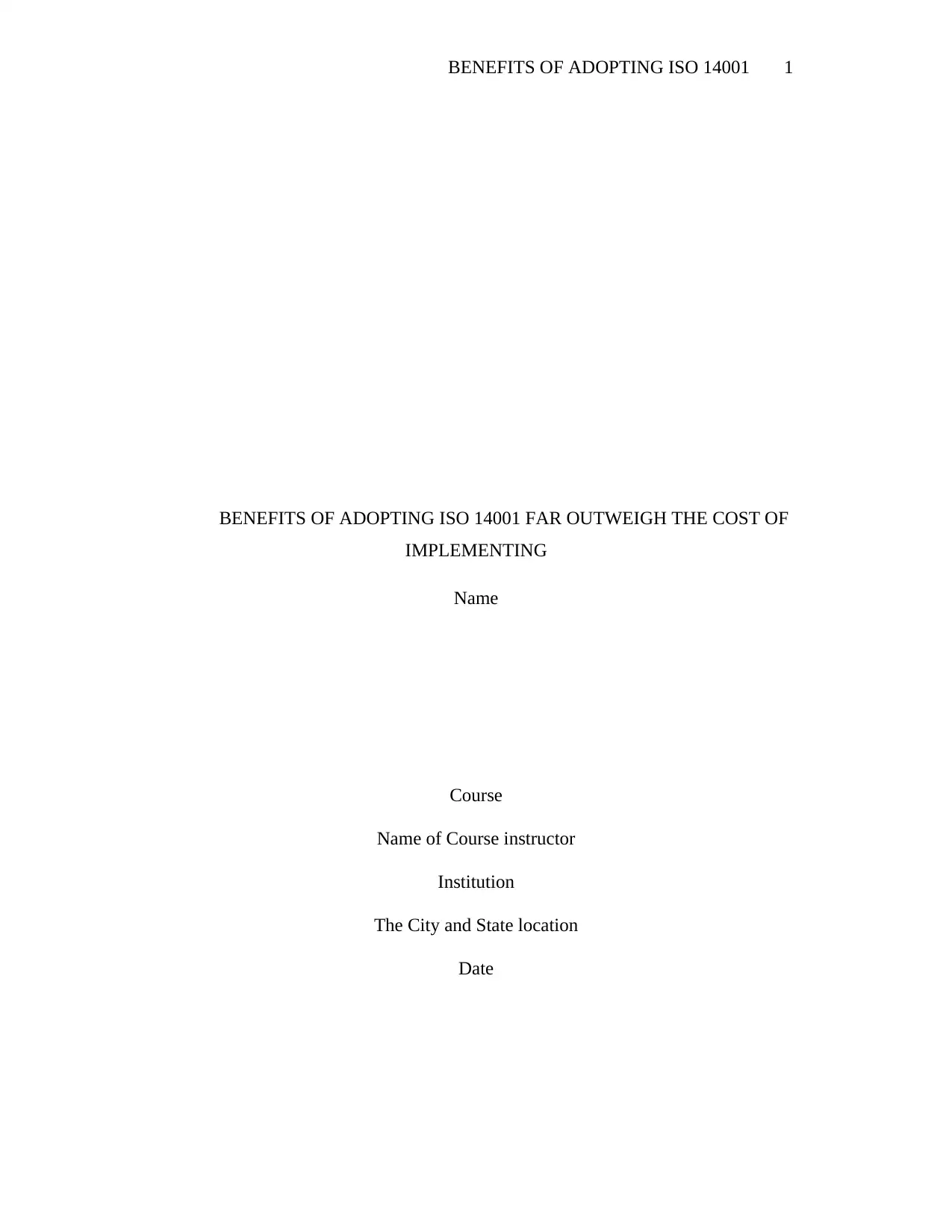
BENEFITS OF ADOPTING ISO 14001 1
BENEFITS OF ADOPTING ISO 14001 FAR OUTWEIGH THE COST OF
IMPLEMENTING
Name
Course
Name of Course instructor
Institution
The City and State location
Date
BENEFITS OF ADOPTING ISO 14001 FAR OUTWEIGH THE COST OF
IMPLEMENTING
Name
Course
Name of Course instructor
Institution
The City and State location
Date
Paraphrase This Document
Need a fresh take? Get an instant paraphrase of this document with our AI Paraphraser
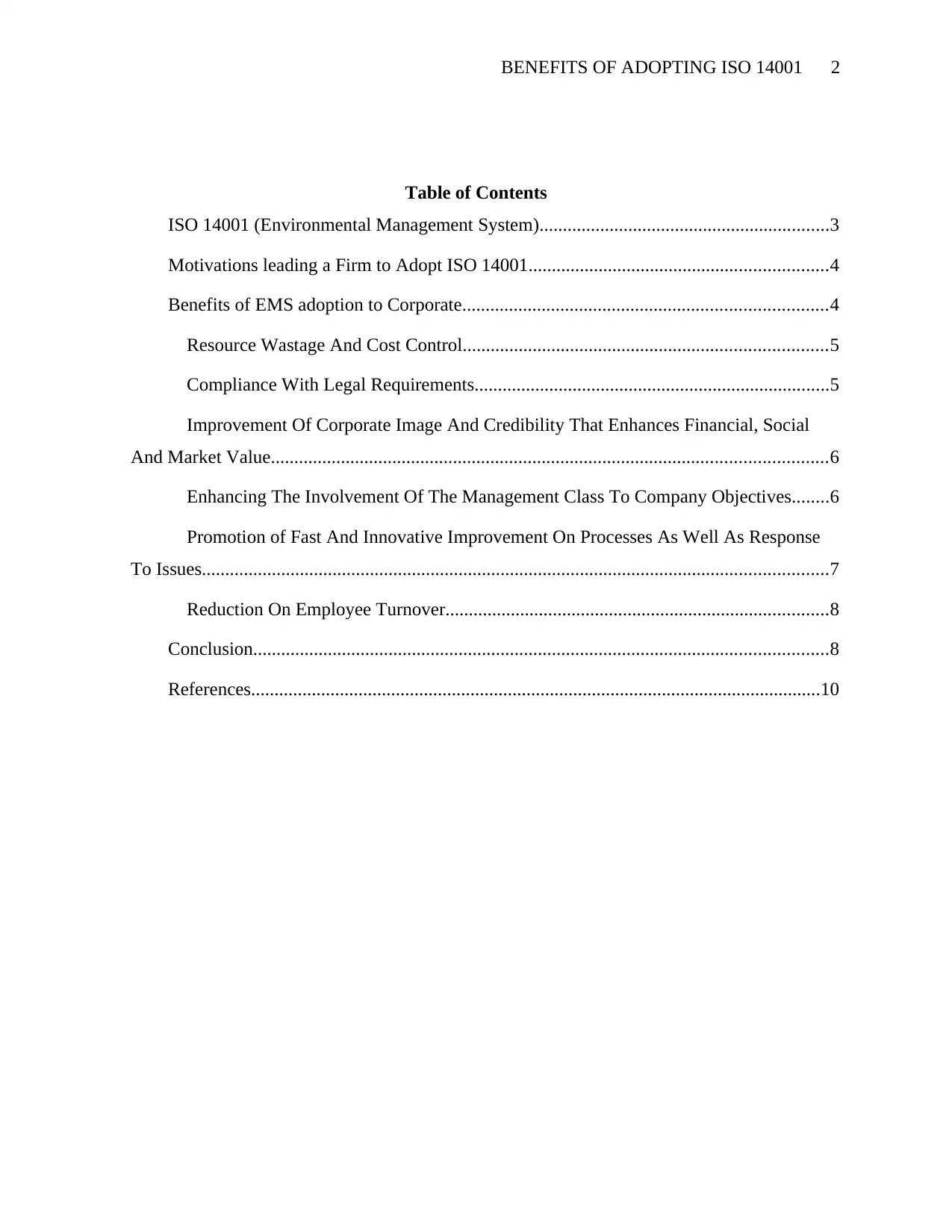
BENEFITS OF ADOPTING ISO 14001 2
Table of Contents
ISO 14001 (Environmental Management System)..............................................................3
Motivations leading a Firm to Adopt ISO 14001................................................................4
Benefits of EMS adoption to Corporate..............................................................................4
Resource Wastage And Cost Control..............................................................................5
Compliance With Legal Requirements............................................................................5
Improvement Of Corporate Image And Credibility That Enhances Financial, Social
And Market Value.......................................................................................................................6
Enhancing The Involvement Of The Management Class To Company Objectives........6
Promotion of Fast And Innovative Improvement On Processes As Well As Response
To Issues......................................................................................................................................7
Reduction On Employee Turnover..................................................................................8
Conclusion...........................................................................................................................8
References..........................................................................................................................10
Table of Contents
ISO 14001 (Environmental Management System)..............................................................3
Motivations leading a Firm to Adopt ISO 14001................................................................4
Benefits of EMS adoption to Corporate..............................................................................4
Resource Wastage And Cost Control..............................................................................5
Compliance With Legal Requirements............................................................................5
Improvement Of Corporate Image And Credibility That Enhances Financial, Social
And Market Value.......................................................................................................................6
Enhancing The Involvement Of The Management Class To Company Objectives........6
Promotion of Fast And Innovative Improvement On Processes As Well As Response
To Issues......................................................................................................................................7
Reduction On Employee Turnover..................................................................................8
Conclusion...........................................................................................................................8
References..........................................................................................................................10
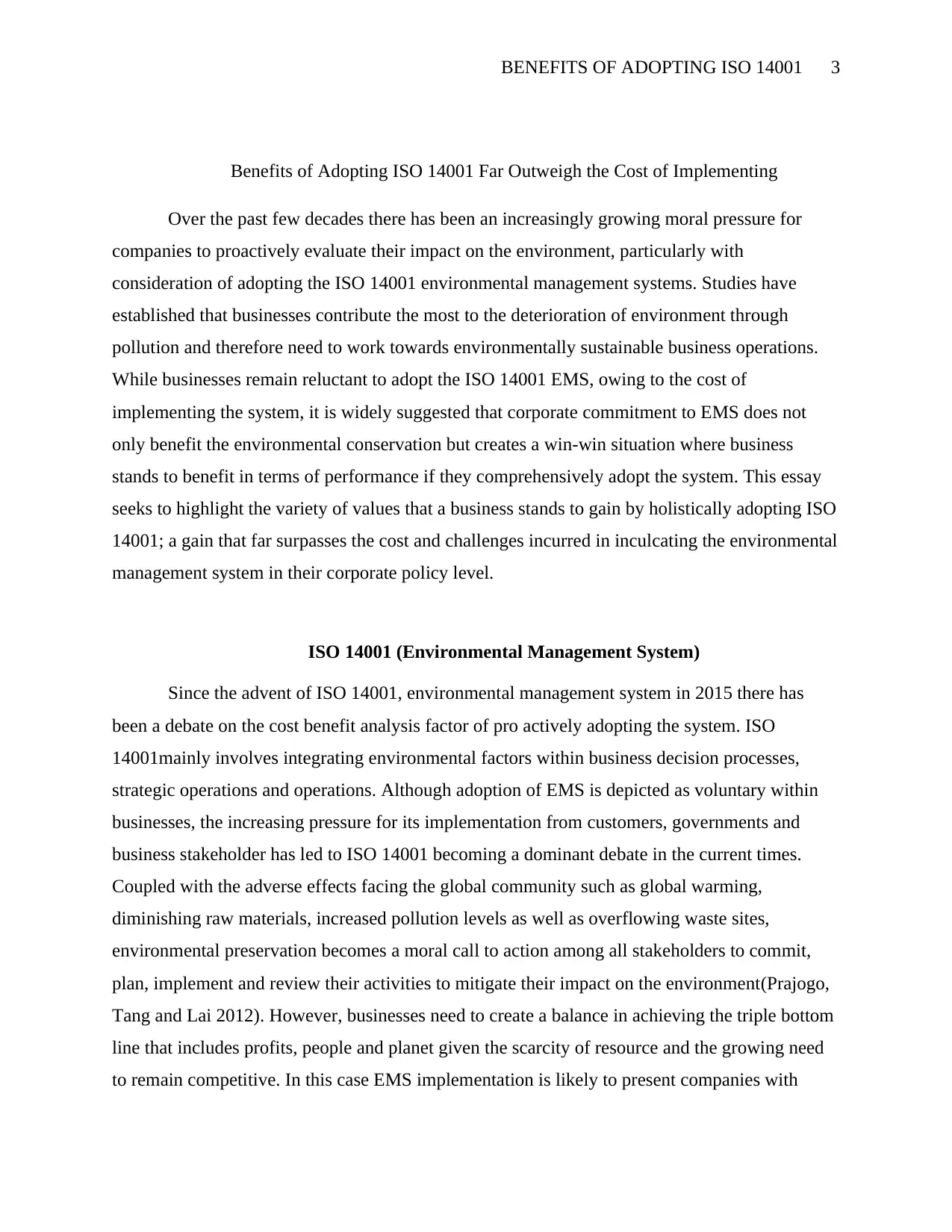
BENEFITS OF ADOPTING ISO 14001 3
Benefits of Adopting ISO 14001 Far Outweigh the Cost of Implementing
Over the past few decades there has been an increasingly growing moral pressure for
companies to proactively evaluate their impact on the environment, particularly with
consideration of adopting the ISO 14001 environmental management systems. Studies have
established that businesses contribute the most to the deterioration of environment through
pollution and therefore need to work towards environmentally sustainable business operations.
While businesses remain reluctant to adopt the ISO 14001 EMS, owing to the cost of
implementing the system, it is widely suggested that corporate commitment to EMS does not
only benefit the environmental conservation but creates a win-win situation where business
stands to benefit in terms of performance if they comprehensively adopt the system. This essay
seeks to highlight the variety of values that a business stands to gain by holistically adopting ISO
14001; a gain that far surpasses the cost and challenges incurred in inculcating the environmental
management system in their corporate policy level.
ISO 14001 (Environmental Management System)
Since the advent of ISO 14001, environmental management system in 2015 there has
been a debate on the cost benefit analysis factor of pro actively adopting the system. ISO
14001mainly involves integrating environmental factors within business decision processes,
strategic operations and operations. Although adoption of EMS is depicted as voluntary within
businesses, the increasing pressure for its implementation from customers, governments and
business stakeholder has led to ISO 14001 becoming a dominant debate in the current times.
Coupled with the adverse effects facing the global community such as global warming,
diminishing raw materials, increased pollution levels as well as overflowing waste sites,
environmental preservation becomes a moral call to action among all stakeholders to commit,
plan, implement and review their activities to mitigate their impact on the environment(Prajogo,
Tang and Lai 2012). However, businesses need to create a balance in achieving the triple bottom
line that includes profits, people and planet given the scarcity of resource and the growing need
to remain competitive. In this case EMS implementation is likely to present companies with
Benefits of Adopting ISO 14001 Far Outweigh the Cost of Implementing
Over the past few decades there has been an increasingly growing moral pressure for
companies to proactively evaluate their impact on the environment, particularly with
consideration of adopting the ISO 14001 environmental management systems. Studies have
established that businesses contribute the most to the deterioration of environment through
pollution and therefore need to work towards environmentally sustainable business operations.
While businesses remain reluctant to adopt the ISO 14001 EMS, owing to the cost of
implementing the system, it is widely suggested that corporate commitment to EMS does not
only benefit the environmental conservation but creates a win-win situation where business
stands to benefit in terms of performance if they comprehensively adopt the system. This essay
seeks to highlight the variety of values that a business stands to gain by holistically adopting ISO
14001; a gain that far surpasses the cost and challenges incurred in inculcating the environmental
management system in their corporate policy level.
ISO 14001 (Environmental Management System)
Since the advent of ISO 14001, environmental management system in 2015 there has
been a debate on the cost benefit analysis factor of pro actively adopting the system. ISO
14001mainly involves integrating environmental factors within business decision processes,
strategic operations and operations. Although adoption of EMS is depicted as voluntary within
businesses, the increasing pressure for its implementation from customers, governments and
business stakeholder has led to ISO 14001 becoming a dominant debate in the current times.
Coupled with the adverse effects facing the global community such as global warming,
diminishing raw materials, increased pollution levels as well as overflowing waste sites,
environmental preservation becomes a moral call to action among all stakeholders to commit,
plan, implement and review their activities to mitigate their impact on the environment(Prajogo,
Tang and Lai 2012). However, businesses need to create a balance in achieving the triple bottom
line that includes profits, people and planet given the scarcity of resource and the growing need
to remain competitive. In this case EMS implementation is likely to present companies with
⊘ This is a preview!⊘
Do you want full access?
Subscribe today to unlock all pages.

Trusted by 1+ million students worldwide
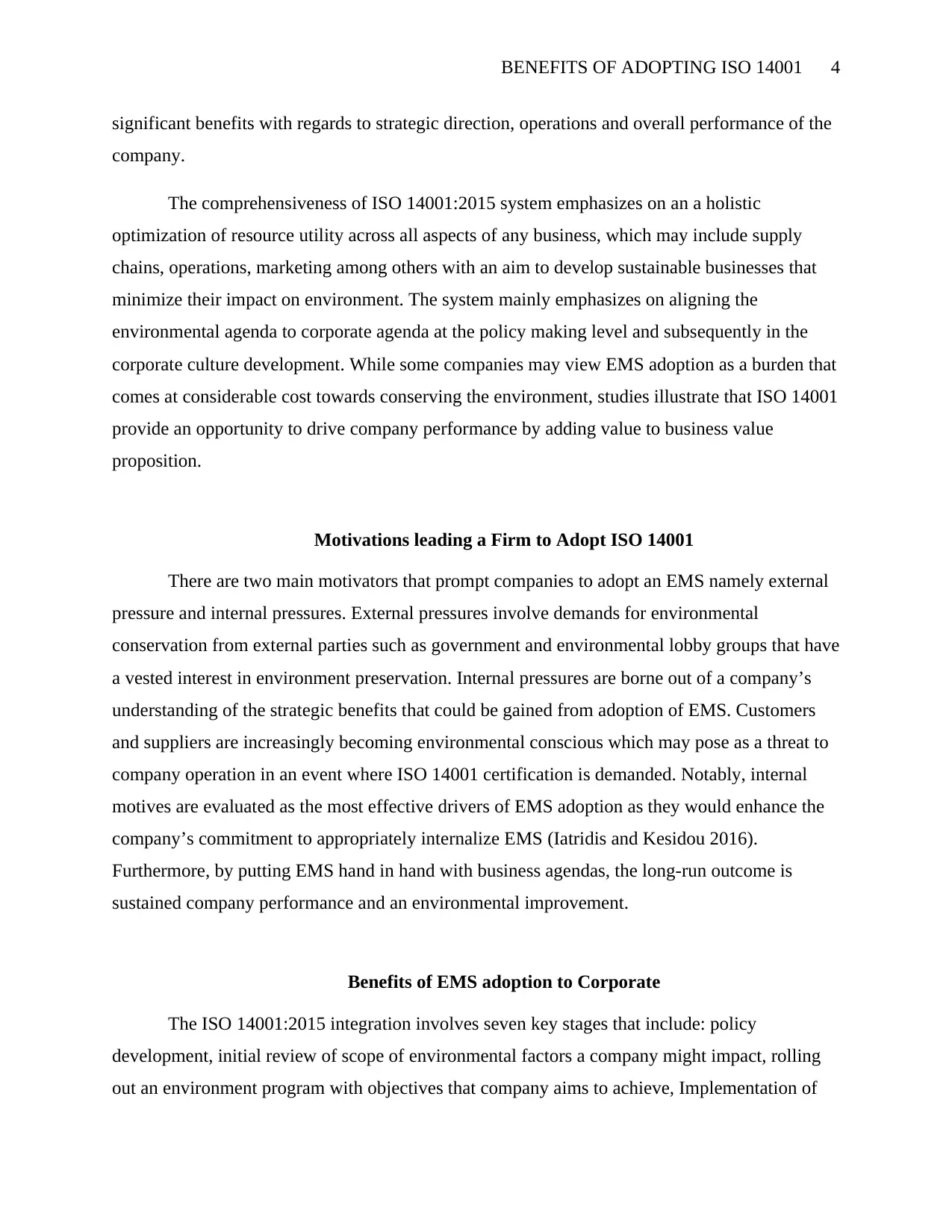
BENEFITS OF ADOPTING ISO 14001 4
significant benefits with regards to strategic direction, operations and overall performance of the
company.
The comprehensiveness of ISO 14001:2015 system emphasizes on an a holistic
optimization of resource utility across all aspects of any business, which may include supply
chains, operations, marketing among others with an aim to develop sustainable businesses that
minimize their impact on environment. The system mainly emphasizes on aligning the
environmental agenda to corporate agenda at the policy making level and subsequently in the
corporate culture development. While some companies may view EMS adoption as a burden that
comes at considerable cost towards conserving the environment, studies illustrate that ISO 14001
provide an opportunity to drive company performance by adding value to business value
proposition.
Motivations leading a Firm to Adopt ISO 14001
There are two main motivators that prompt companies to adopt an EMS namely external
pressure and internal pressures. External pressures involve demands for environmental
conservation from external parties such as government and environmental lobby groups that have
a vested interest in environment preservation. Internal pressures are borne out of a company’s
understanding of the strategic benefits that could be gained from adoption of EMS. Customers
and suppliers are increasingly becoming environmental conscious which may pose as a threat to
company operation in an event where ISO 14001 certification is demanded. Notably, internal
motives are evaluated as the most effective drivers of EMS adoption as they would enhance the
company’s commitment to appropriately internalize EMS (Iatridis and Kesidou 2016).
Furthermore, by putting EMS hand in hand with business agendas, the long-run outcome is
sustained company performance and an environmental improvement.
Benefits of EMS adoption to Corporate
The ISO 14001:2015 integration involves seven key stages that include: policy
development, initial review of scope of environmental factors a company might impact, rolling
out an environment program with objectives that company aims to achieve, Implementation of
significant benefits with regards to strategic direction, operations and overall performance of the
company.
The comprehensiveness of ISO 14001:2015 system emphasizes on an a holistic
optimization of resource utility across all aspects of any business, which may include supply
chains, operations, marketing among others with an aim to develop sustainable businesses that
minimize their impact on environment. The system mainly emphasizes on aligning the
environmental agenda to corporate agenda at the policy making level and subsequently in the
corporate culture development. While some companies may view EMS adoption as a burden that
comes at considerable cost towards conserving the environment, studies illustrate that ISO 14001
provide an opportunity to drive company performance by adding value to business value
proposition.
Motivations leading a Firm to Adopt ISO 14001
There are two main motivators that prompt companies to adopt an EMS namely external
pressure and internal pressures. External pressures involve demands for environmental
conservation from external parties such as government and environmental lobby groups that have
a vested interest in environment preservation. Internal pressures are borne out of a company’s
understanding of the strategic benefits that could be gained from adoption of EMS. Customers
and suppliers are increasingly becoming environmental conscious which may pose as a threat to
company operation in an event where ISO 14001 certification is demanded. Notably, internal
motives are evaluated as the most effective drivers of EMS adoption as they would enhance the
company’s commitment to appropriately internalize EMS (Iatridis and Kesidou 2016).
Furthermore, by putting EMS hand in hand with business agendas, the long-run outcome is
sustained company performance and an environmental improvement.
Benefits of EMS adoption to Corporate
The ISO 14001:2015 integration involves seven key stages that include: policy
development, initial review of scope of environmental factors a company might impact, rolling
out an environment program with objectives that company aims to achieve, Implementation of
Paraphrase This Document
Need a fresh take? Get an instant paraphrase of this document with our AI Paraphraser
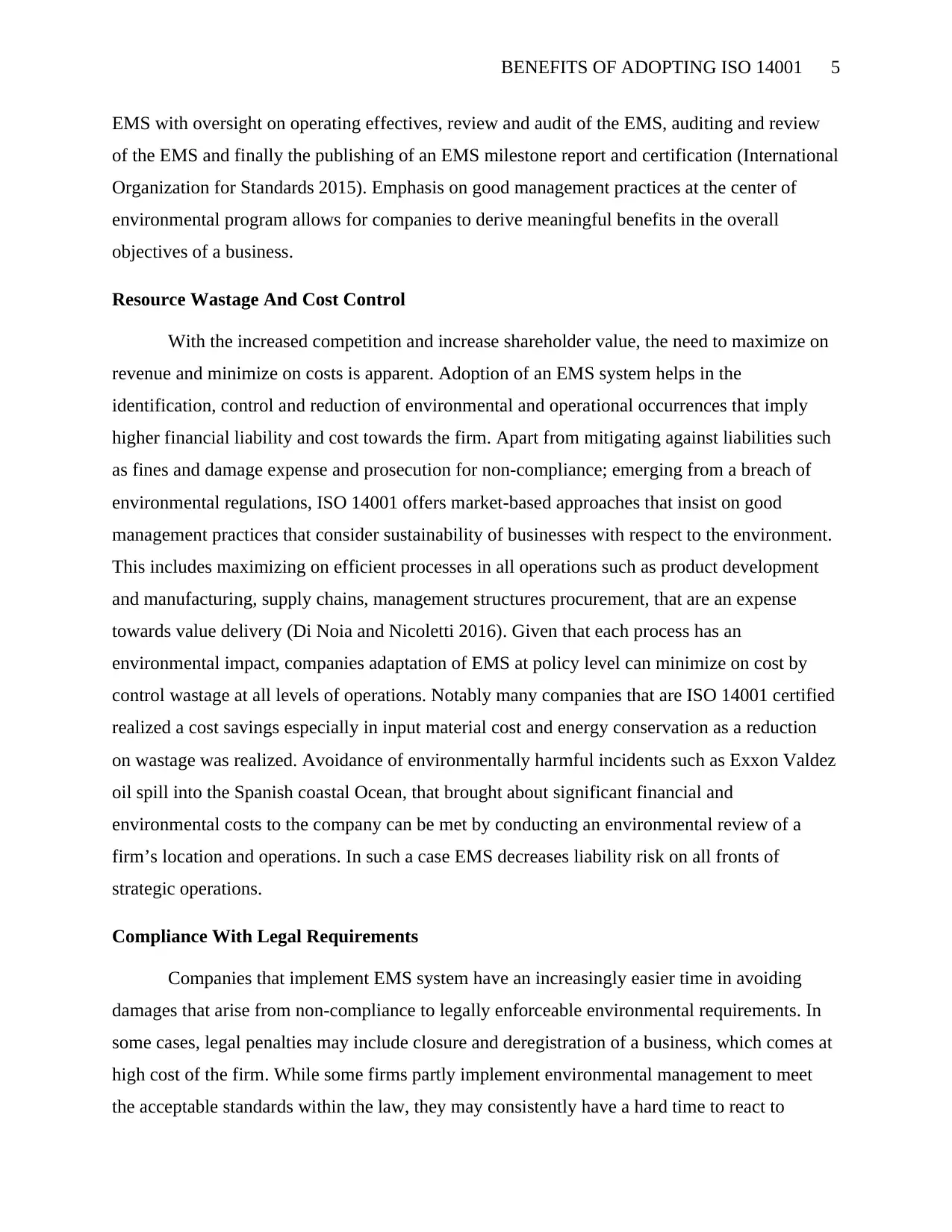
BENEFITS OF ADOPTING ISO 14001 5
EMS with oversight on operating effectives, review and audit of the EMS, auditing and review
of the EMS and finally the publishing of an EMS milestone report and certification (International
Organization for Standards 2015). Emphasis on good management practices at the center of
environmental program allows for companies to derive meaningful benefits in the overall
objectives of a business.
Resource Wastage And Cost Control
With the increased competition and increase shareholder value, the need to maximize on
revenue and minimize on costs is apparent. Adoption of an EMS system helps in the
identification, control and reduction of environmental and operational occurrences that imply
higher financial liability and cost towards the firm. Apart from mitigating against liabilities such
as fines and damage expense and prosecution for non-compliance; emerging from a breach of
environmental regulations, ISO 14001 offers market-based approaches that insist on good
management practices that consider sustainability of businesses with respect to the environment.
This includes maximizing on efficient processes in all operations such as product development
and manufacturing, supply chains, management structures procurement, that are an expense
towards value delivery (Di Noia and Nicoletti 2016). Given that each process has an
environmental impact, companies adaptation of EMS at policy level can minimize on cost by
control wastage at all levels of operations. Notably many companies that are ISO 14001 certified
realized a cost savings especially in input material cost and energy conservation as a reduction
on wastage was realized. Avoidance of environmentally harmful incidents such as Exxon Valdez
oil spill into the Spanish coastal Ocean, that brought about significant financial and
environmental costs to the company can be met by conducting an environmental review of a
firm’s location and operations. In such a case EMS decreases liability risk on all fronts of
strategic operations.
Compliance With Legal Requirements
Companies that implement EMS system have an increasingly easier time in avoiding
damages that arise from non-compliance to legally enforceable environmental requirements. In
some cases, legal penalties may include closure and deregistration of a business, which comes at
high cost of the firm. While some firms partly implement environmental management to meet
the acceptable standards within the law, they may consistently have a hard time to react to
EMS with oversight on operating effectives, review and audit of the EMS, auditing and review
of the EMS and finally the publishing of an EMS milestone report and certification (International
Organization for Standards 2015). Emphasis on good management practices at the center of
environmental program allows for companies to derive meaningful benefits in the overall
objectives of a business.
Resource Wastage And Cost Control
With the increased competition and increase shareholder value, the need to maximize on
revenue and minimize on costs is apparent. Adoption of an EMS system helps in the
identification, control and reduction of environmental and operational occurrences that imply
higher financial liability and cost towards the firm. Apart from mitigating against liabilities such
as fines and damage expense and prosecution for non-compliance; emerging from a breach of
environmental regulations, ISO 14001 offers market-based approaches that insist on good
management practices that consider sustainability of businesses with respect to the environment.
This includes maximizing on efficient processes in all operations such as product development
and manufacturing, supply chains, management structures procurement, that are an expense
towards value delivery (Di Noia and Nicoletti 2016). Given that each process has an
environmental impact, companies adaptation of EMS at policy level can minimize on cost by
control wastage at all levels of operations. Notably many companies that are ISO 14001 certified
realized a cost savings especially in input material cost and energy conservation as a reduction
on wastage was realized. Avoidance of environmentally harmful incidents such as Exxon Valdez
oil spill into the Spanish coastal Ocean, that brought about significant financial and
environmental costs to the company can be met by conducting an environmental review of a
firm’s location and operations. In such a case EMS decreases liability risk on all fronts of
strategic operations.
Compliance With Legal Requirements
Companies that implement EMS system have an increasingly easier time in avoiding
damages that arise from non-compliance to legally enforceable environmental requirements. In
some cases, legal penalties may include closure and deregistration of a business, which comes at
high cost of the firm. While some firms partly implement environmental management to meet
the acceptable standards within the law, they may consistently have a hard time to react to
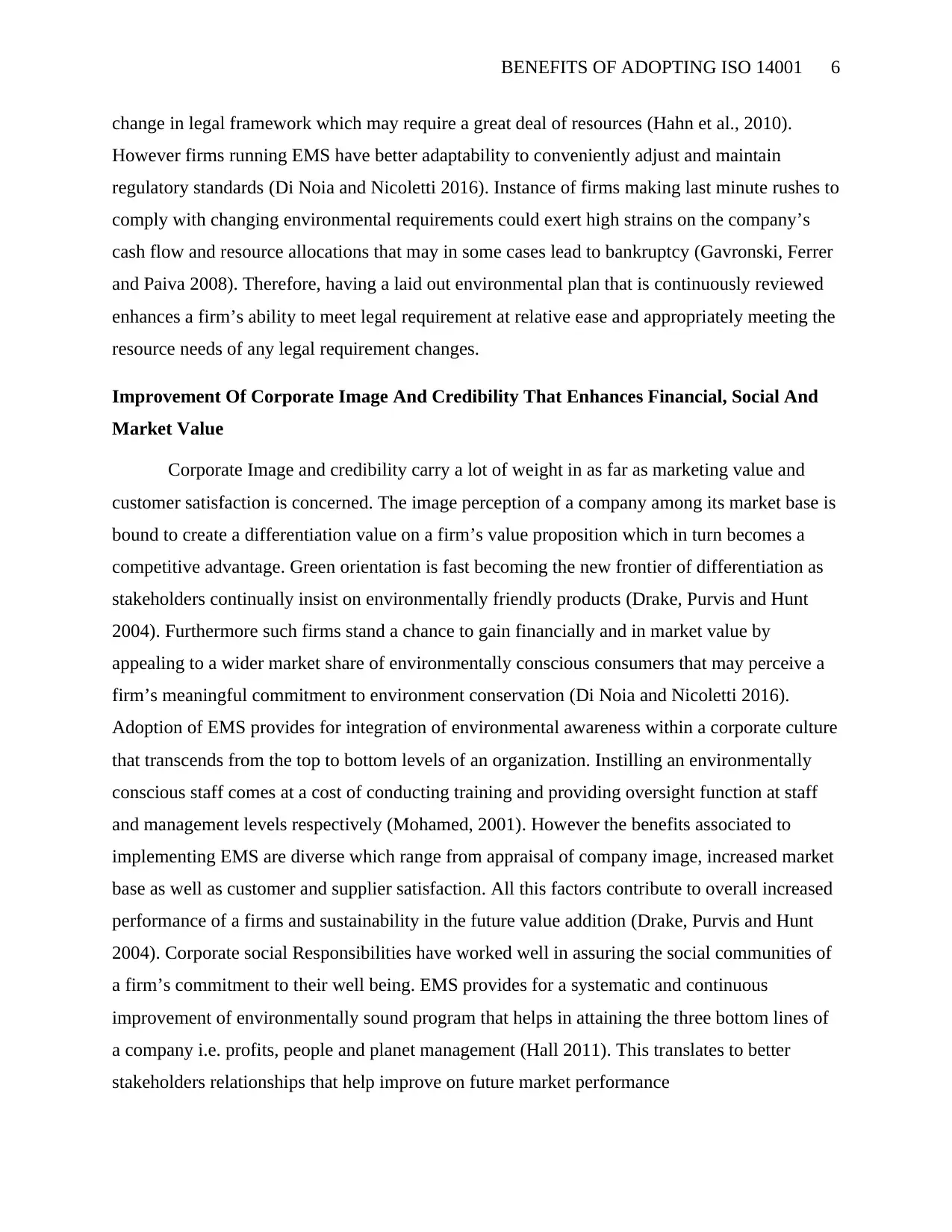
BENEFITS OF ADOPTING ISO 14001 6
change in legal framework which may require a great deal of resources (Hahn et al., 2010).
However firms running EMS have better adaptability to conveniently adjust and maintain
regulatory standards (Di Noia and Nicoletti 2016). Instance of firms making last minute rushes to
comply with changing environmental requirements could exert high strains on the company’s
cash flow and resource allocations that may in some cases lead to bankruptcy (Gavronski, Ferrer
and Paiva 2008). Therefore, having a laid out environmental plan that is continuously reviewed
enhances a firm’s ability to meet legal requirement at relative ease and appropriately meeting the
resource needs of any legal requirement changes.
Improvement Of Corporate Image And Credibility That Enhances Financial, Social And
Market Value
Corporate Image and credibility carry a lot of weight in as far as marketing value and
customer satisfaction is concerned. The image perception of a company among its market base is
bound to create a differentiation value on a firm’s value proposition which in turn becomes a
competitive advantage. Green orientation is fast becoming the new frontier of differentiation as
stakeholders continually insist on environmentally friendly products (Drake, Purvis and Hunt
2004). Furthermore such firms stand a chance to gain financially and in market value by
appealing to a wider market share of environmentally conscious consumers that may perceive a
firm’s meaningful commitment to environment conservation (Di Noia and Nicoletti 2016).
Adoption of EMS provides for integration of environmental awareness within a corporate culture
that transcends from the top to bottom levels of an organization. Instilling an environmentally
conscious staff comes at a cost of conducting training and providing oversight function at staff
and management levels respectively (Mohamed, 2001). However the benefits associated to
implementing EMS are diverse which range from appraisal of company image, increased market
base as well as customer and supplier satisfaction. All this factors contribute to overall increased
performance of a firms and sustainability in the future value addition (Drake, Purvis and Hunt
2004). Corporate social Responsibilities have worked well in assuring the social communities of
a firm’s commitment to their well being. EMS provides for a systematic and continuous
improvement of environmentally sound program that helps in attaining the three bottom lines of
a company i.e. profits, people and planet management (Hall 2011). This translates to better
stakeholders relationships that help improve on future market performance
change in legal framework which may require a great deal of resources (Hahn et al., 2010).
However firms running EMS have better adaptability to conveniently adjust and maintain
regulatory standards (Di Noia and Nicoletti 2016). Instance of firms making last minute rushes to
comply with changing environmental requirements could exert high strains on the company’s
cash flow and resource allocations that may in some cases lead to bankruptcy (Gavronski, Ferrer
and Paiva 2008). Therefore, having a laid out environmental plan that is continuously reviewed
enhances a firm’s ability to meet legal requirement at relative ease and appropriately meeting the
resource needs of any legal requirement changes.
Improvement Of Corporate Image And Credibility That Enhances Financial, Social And
Market Value
Corporate Image and credibility carry a lot of weight in as far as marketing value and
customer satisfaction is concerned. The image perception of a company among its market base is
bound to create a differentiation value on a firm’s value proposition which in turn becomes a
competitive advantage. Green orientation is fast becoming the new frontier of differentiation as
stakeholders continually insist on environmentally friendly products (Drake, Purvis and Hunt
2004). Furthermore such firms stand a chance to gain financially and in market value by
appealing to a wider market share of environmentally conscious consumers that may perceive a
firm’s meaningful commitment to environment conservation (Di Noia and Nicoletti 2016).
Adoption of EMS provides for integration of environmental awareness within a corporate culture
that transcends from the top to bottom levels of an organization. Instilling an environmentally
conscious staff comes at a cost of conducting training and providing oversight function at staff
and management levels respectively (Mohamed, 2001). However the benefits associated to
implementing EMS are diverse which range from appraisal of company image, increased market
base as well as customer and supplier satisfaction. All this factors contribute to overall increased
performance of a firms and sustainability in the future value addition (Drake, Purvis and Hunt
2004). Corporate social Responsibilities have worked well in assuring the social communities of
a firm’s commitment to their well being. EMS provides for a systematic and continuous
improvement of environmentally sound program that helps in attaining the three bottom lines of
a company i.e. profits, people and planet management (Hall 2011). This translates to better
stakeholders relationships that help improve on future market performance
⊘ This is a preview!⊘
Do you want full access?
Subscribe today to unlock all pages.

Trusted by 1+ million students worldwide
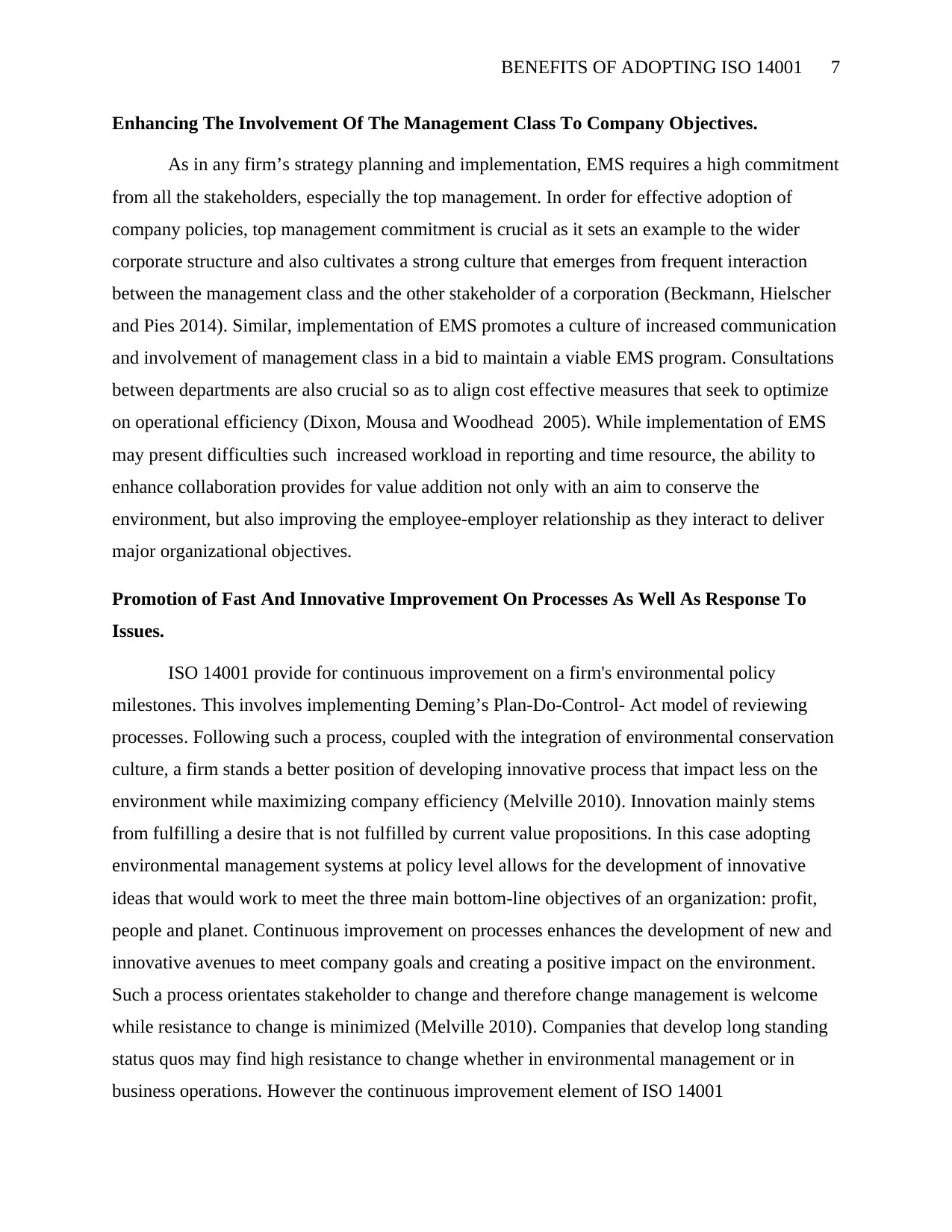
BENEFITS OF ADOPTING ISO 14001 7
Enhancing The Involvement Of The Management Class To Company Objectives.
As in any firm’s strategy planning and implementation, EMS requires a high commitment
from all the stakeholders, especially the top management. In order for effective adoption of
company policies, top management commitment is crucial as it sets an example to the wider
corporate structure and also cultivates a strong culture that emerges from frequent interaction
between the management class and the other stakeholder of a corporation (Beckmann, Hielscher
and Pies 2014). Similar, implementation of EMS promotes a culture of increased communication
and involvement of management class in a bid to maintain a viable EMS program. Consultations
between departments are also crucial so as to align cost effective measures that seek to optimize
on operational efficiency (Dixon, Mousa and Woodhead 2005). While implementation of EMS
may present difficulties such increased workload in reporting and time resource, the ability to
enhance collaboration provides for value addition not only with an aim to conserve the
environment, but also improving the employee-employer relationship as they interact to deliver
major organizational objectives.
Promotion of Fast And Innovative Improvement On Processes As Well As Response To
Issues.
ISO 14001 provide for continuous improvement on a firm's environmental policy
milestones. This involves implementing Deming’s Plan-Do-Control- Act model of reviewing
processes. Following such a process, coupled with the integration of environmental conservation
culture, a firm stands a better position of developing innovative process that impact less on the
environment while maximizing company efficiency (Melville 2010). Innovation mainly stems
from fulfilling a desire that is not fulfilled by current value propositions. In this case adopting
environmental management systems at policy level allows for the development of innovative
ideas that would work to meet the three main bottom-line objectives of an organization: profit,
people and planet. Continuous improvement on processes enhances the development of new and
innovative avenues to meet company goals and creating a positive impact on the environment.
Such a process orientates stakeholder to change and therefore change management is welcome
while resistance to change is minimized (Melville 2010). Companies that develop long standing
status quos may find high resistance to change whether in environmental management or in
business operations. However the continuous improvement element of ISO 14001
Enhancing The Involvement Of The Management Class To Company Objectives.
As in any firm’s strategy planning and implementation, EMS requires a high commitment
from all the stakeholders, especially the top management. In order for effective adoption of
company policies, top management commitment is crucial as it sets an example to the wider
corporate structure and also cultivates a strong culture that emerges from frequent interaction
between the management class and the other stakeholder of a corporation (Beckmann, Hielscher
and Pies 2014). Similar, implementation of EMS promotes a culture of increased communication
and involvement of management class in a bid to maintain a viable EMS program. Consultations
between departments are also crucial so as to align cost effective measures that seek to optimize
on operational efficiency (Dixon, Mousa and Woodhead 2005). While implementation of EMS
may present difficulties such increased workload in reporting and time resource, the ability to
enhance collaboration provides for value addition not only with an aim to conserve the
environment, but also improving the employee-employer relationship as they interact to deliver
major organizational objectives.
Promotion of Fast And Innovative Improvement On Processes As Well As Response To
Issues.
ISO 14001 provide for continuous improvement on a firm's environmental policy
milestones. This involves implementing Deming’s Plan-Do-Control- Act model of reviewing
processes. Following such a process, coupled with the integration of environmental conservation
culture, a firm stands a better position of developing innovative process that impact less on the
environment while maximizing company efficiency (Melville 2010). Innovation mainly stems
from fulfilling a desire that is not fulfilled by current value propositions. In this case adopting
environmental management systems at policy level allows for the development of innovative
ideas that would work to meet the three main bottom-line objectives of an organization: profit,
people and planet. Continuous improvement on processes enhances the development of new and
innovative avenues to meet company goals and creating a positive impact on the environment.
Such a process orientates stakeholder to change and therefore change management is welcome
while resistance to change is minimized (Melville 2010). Companies that develop long standing
status quos may find high resistance to change whether in environmental management or in
business operations. However the continuous improvement element of ISO 14001
Paraphrase This Document
Need a fresh take? Get an instant paraphrase of this document with our AI Paraphraser
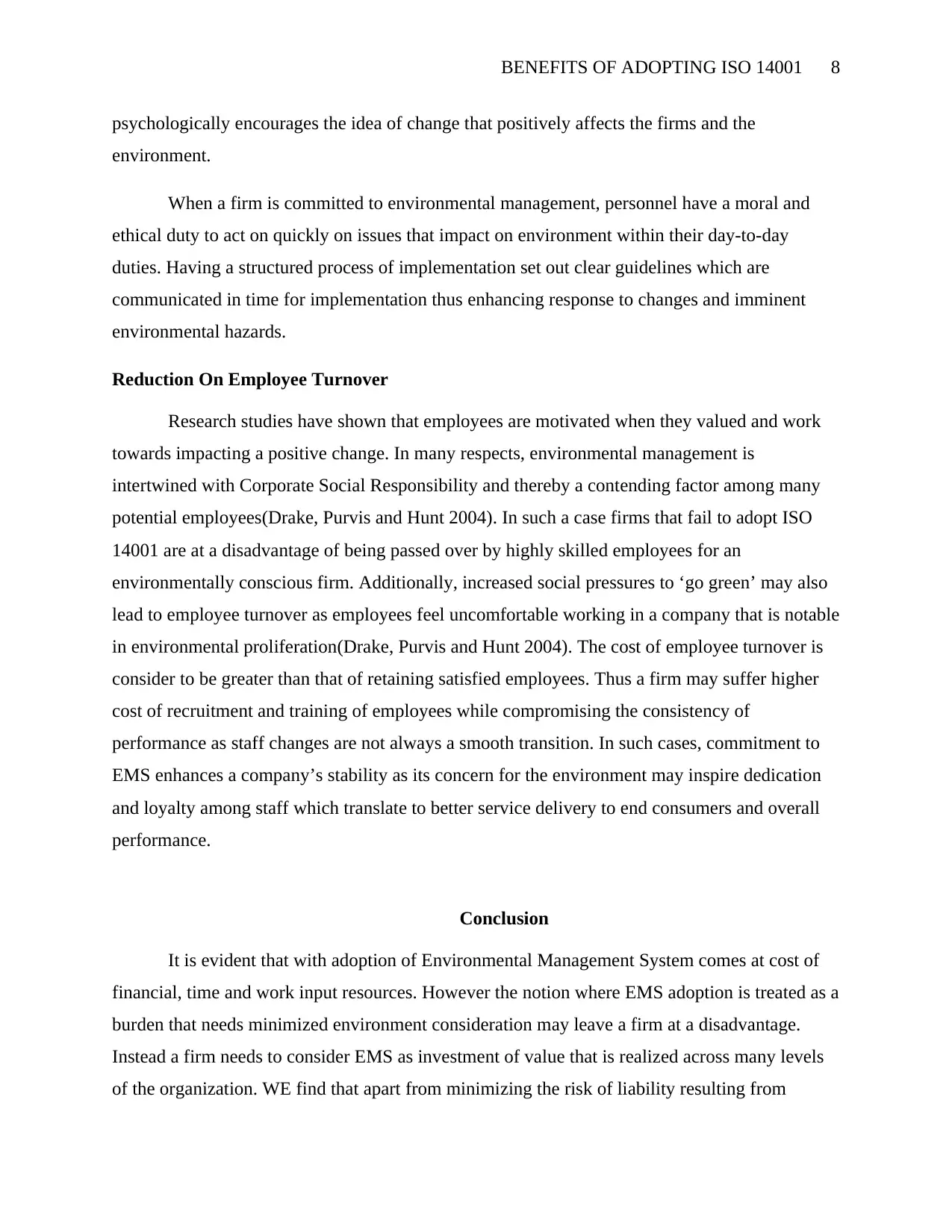
BENEFITS OF ADOPTING ISO 14001 8
psychologically encourages the idea of change that positively affects the firms and the
environment.
When a firm is committed to environmental management, personnel have a moral and
ethical duty to act on quickly on issues that impact on environment within their day-to-day
duties. Having a structured process of implementation set out clear guidelines which are
communicated in time for implementation thus enhancing response to changes and imminent
environmental hazards.
Reduction On Employee Turnover
Research studies have shown that employees are motivated when they valued and work
towards impacting a positive change. In many respects, environmental management is
intertwined with Corporate Social Responsibility and thereby a contending factor among many
potential employees(Drake, Purvis and Hunt 2004). In such a case firms that fail to adopt ISO
14001 are at a disadvantage of being passed over by highly skilled employees for an
environmentally conscious firm. Additionally, increased social pressures to ‘go green’ may also
lead to employee turnover as employees feel uncomfortable working in a company that is notable
in environmental proliferation(Drake, Purvis and Hunt 2004). The cost of employee turnover is
consider to be greater than that of retaining satisfied employees. Thus a firm may suffer higher
cost of recruitment and training of employees while compromising the consistency of
performance as staff changes are not always a smooth transition. In such cases, commitment to
EMS enhances a company’s stability as its concern for the environment may inspire dedication
and loyalty among staff which translate to better service delivery to end consumers and overall
performance.
Conclusion
It is evident that with adoption of Environmental Management System comes at cost of
financial, time and work input resources. However the notion where EMS adoption is treated as a
burden that needs minimized environment consideration may leave a firm at a disadvantage.
Instead a firm needs to consider EMS as investment of value that is realized across many levels
of the organization. WE find that apart from minimizing the risk of liability resulting from
psychologically encourages the idea of change that positively affects the firms and the
environment.
When a firm is committed to environmental management, personnel have a moral and
ethical duty to act on quickly on issues that impact on environment within their day-to-day
duties. Having a structured process of implementation set out clear guidelines which are
communicated in time for implementation thus enhancing response to changes and imminent
environmental hazards.
Reduction On Employee Turnover
Research studies have shown that employees are motivated when they valued and work
towards impacting a positive change. In many respects, environmental management is
intertwined with Corporate Social Responsibility and thereby a contending factor among many
potential employees(Drake, Purvis and Hunt 2004). In such a case firms that fail to adopt ISO
14001 are at a disadvantage of being passed over by highly skilled employees for an
environmentally conscious firm. Additionally, increased social pressures to ‘go green’ may also
lead to employee turnover as employees feel uncomfortable working in a company that is notable
in environmental proliferation(Drake, Purvis and Hunt 2004). The cost of employee turnover is
consider to be greater than that of retaining satisfied employees. Thus a firm may suffer higher
cost of recruitment and training of employees while compromising the consistency of
performance as staff changes are not always a smooth transition. In such cases, commitment to
EMS enhances a company’s stability as its concern for the environment may inspire dedication
and loyalty among staff which translate to better service delivery to end consumers and overall
performance.
Conclusion
It is evident that with adoption of Environmental Management System comes at cost of
financial, time and work input resources. However the notion where EMS adoption is treated as a
burden that needs minimized environment consideration may leave a firm at a disadvantage.
Instead a firm needs to consider EMS as investment of value that is realized across many levels
of the organization. WE find that apart from minimizing the risk of liability resulting from
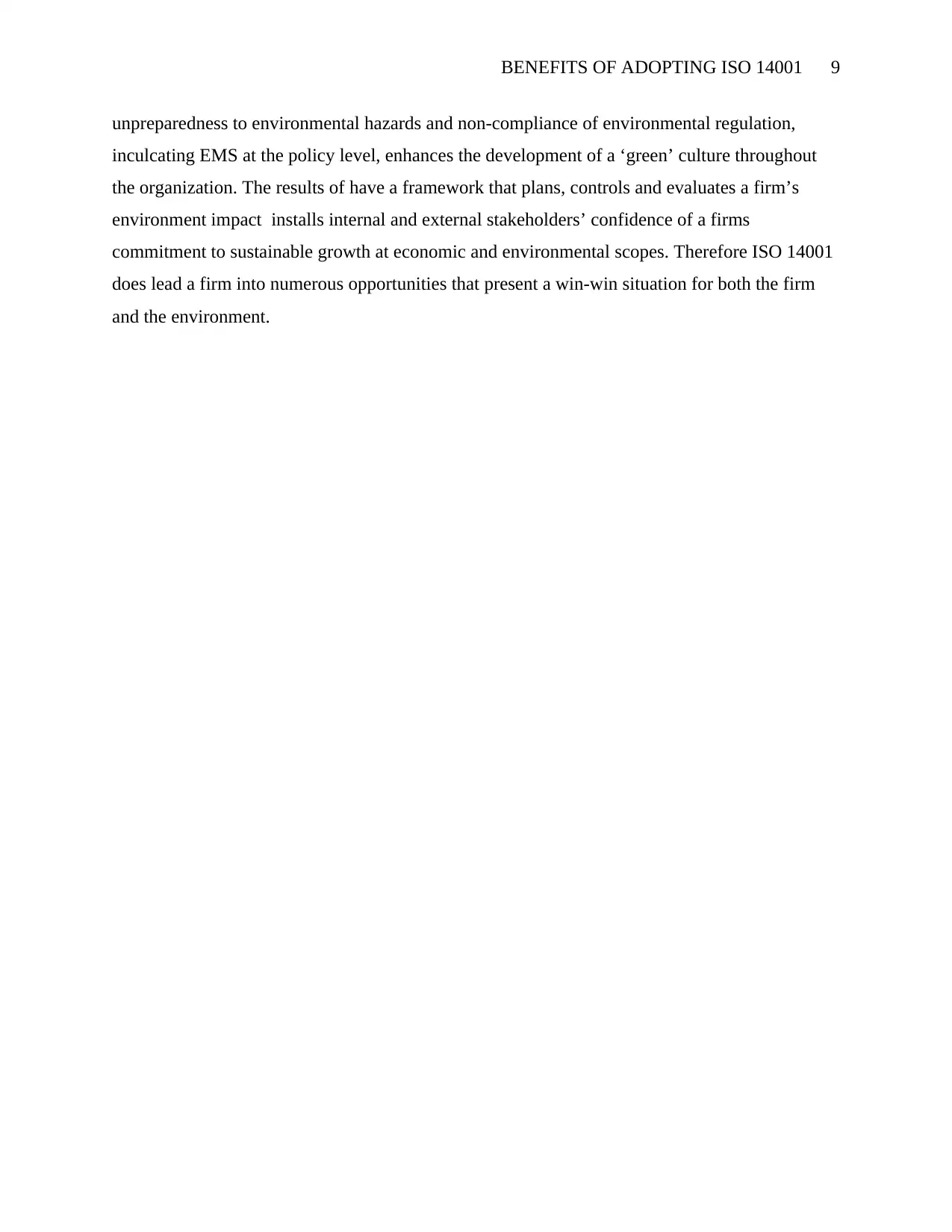
BENEFITS OF ADOPTING ISO 14001 9
unpreparedness to environmental hazards and non-compliance of environmental regulation,
inculcating EMS at the policy level, enhances the development of a ‘green’ culture throughout
the organization. The results of have a framework that plans, controls and evaluates a firm’s
environment impact installs internal and external stakeholders’ confidence of a firms
commitment to sustainable growth at economic and environmental scopes. Therefore ISO 14001
does lead a firm into numerous opportunities that present a win-win situation for both the firm
and the environment.
unpreparedness to environmental hazards and non-compliance of environmental regulation,
inculcating EMS at the policy level, enhances the development of a ‘green’ culture throughout
the organization. The results of have a framework that plans, controls and evaluates a firm’s
environment impact installs internal and external stakeholders’ confidence of a firms
commitment to sustainable growth at economic and environmental scopes. Therefore ISO 14001
does lead a firm into numerous opportunities that present a win-win situation for both the firm
and the environment.
⊘ This is a preview!⊘
Do you want full access?
Subscribe today to unlock all pages.

Trusted by 1+ million students worldwide
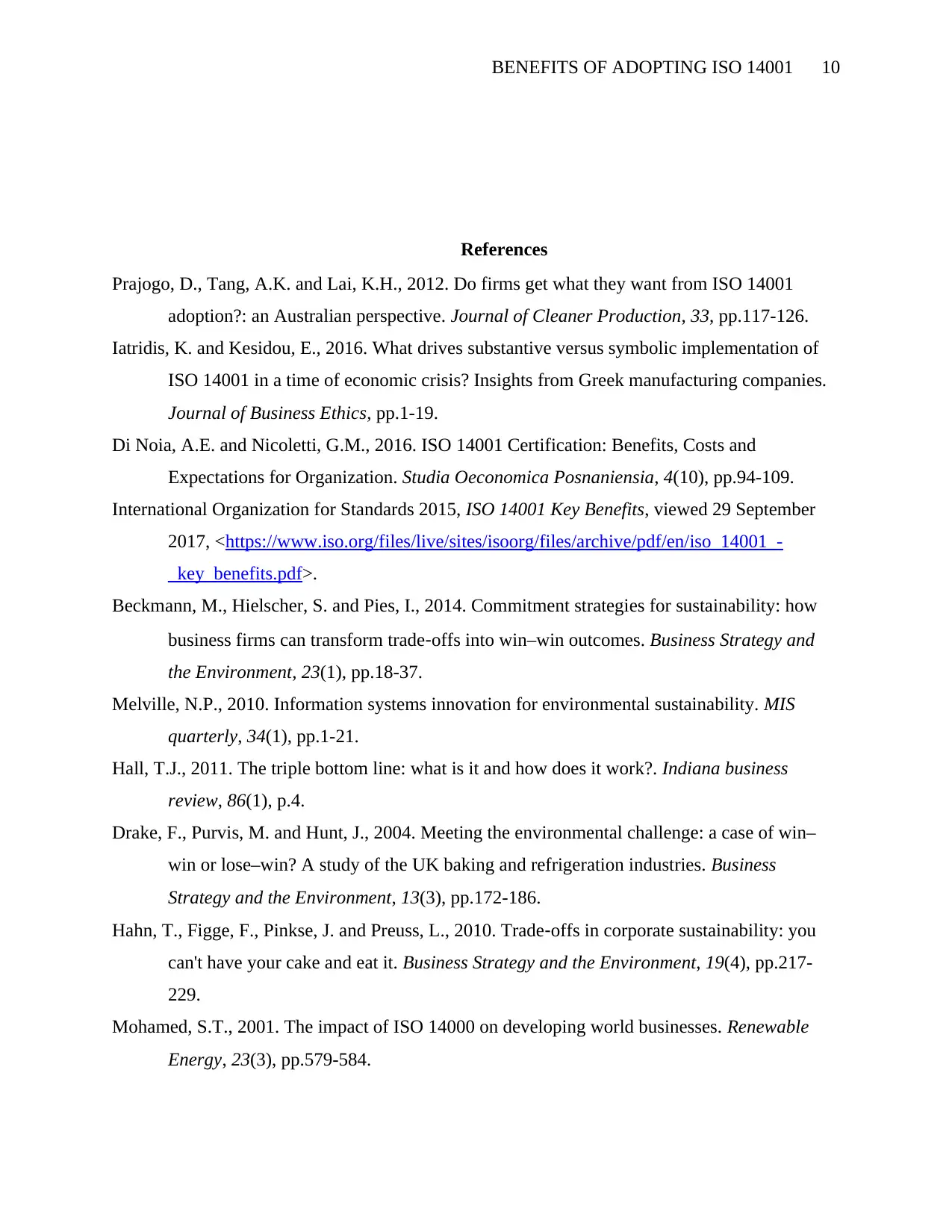
BENEFITS OF ADOPTING ISO 14001 10
References
Prajogo, D., Tang, A.K. and Lai, K.H., 2012. Do firms get what they want from ISO 14001
adoption?: an Australian perspective. Journal of Cleaner Production, 33, pp.117-126.
Iatridis, K. and Kesidou, E., 2016. What drives substantive versus symbolic implementation of
ISO 14001 in a time of economic crisis? Insights from Greek manufacturing companies.
Journal of Business Ethics, pp.1-19.
Di Noia, A.E. and Nicoletti, G.M., 2016. ISO 14001 Certification: Benefits, Costs and
Expectations for Organization. Studia Oeconomica Posnaniensia, 4(10), pp.94-109.
International Organization for Standards 2015, ISO 14001 Key Benefits, viewed 29 September
2017, <https://www.iso.org/files/live/sites/isoorg/files/archive/pdf/en/iso_14001_-
_key_benefits.pdf>.
Beckmann, M., Hielscher, S. and Pies, I., 2014. Commitment strategies for sustainability: how
business firms can transform trade‐offs into win–win outcomes. Business Strategy and
the Environment, 23(1), pp.18-37.
Melville, N.P., 2010. Information systems innovation for environmental sustainability. MIS
quarterly, 34(1), pp.1-21.
Hall, T.J., 2011. The triple bottom line: what is it and how does it work?. Indiana business
review, 86(1), p.4.
Drake, F., Purvis, M. and Hunt, J., 2004. Meeting the environmental challenge: a case of win–
win or lose–win? A study of the UK baking and refrigeration industries. Business
Strategy and the Environment, 13(3), pp.172-186.
Hahn, T., Figge, F., Pinkse, J. and Preuss, L., 2010. Trade‐offs in corporate sustainability: you
can't have your cake and eat it. Business Strategy and the Environment, 19(4), pp.217-
229.
Mohamed, S.T., 2001. The impact of ISO 14000 on developing world businesses. Renewable
Energy, 23(3), pp.579-584.
References
Prajogo, D., Tang, A.K. and Lai, K.H., 2012. Do firms get what they want from ISO 14001
adoption?: an Australian perspective. Journal of Cleaner Production, 33, pp.117-126.
Iatridis, K. and Kesidou, E., 2016. What drives substantive versus symbolic implementation of
ISO 14001 in a time of economic crisis? Insights from Greek manufacturing companies.
Journal of Business Ethics, pp.1-19.
Di Noia, A.E. and Nicoletti, G.M., 2016. ISO 14001 Certification: Benefits, Costs and
Expectations for Organization. Studia Oeconomica Posnaniensia, 4(10), pp.94-109.
International Organization for Standards 2015, ISO 14001 Key Benefits, viewed 29 September
2017, <https://www.iso.org/files/live/sites/isoorg/files/archive/pdf/en/iso_14001_-
_key_benefits.pdf>.
Beckmann, M., Hielscher, S. and Pies, I., 2014. Commitment strategies for sustainability: how
business firms can transform trade‐offs into win–win outcomes. Business Strategy and
the Environment, 23(1), pp.18-37.
Melville, N.P., 2010. Information systems innovation for environmental sustainability. MIS
quarterly, 34(1), pp.1-21.
Hall, T.J., 2011. The triple bottom line: what is it and how does it work?. Indiana business
review, 86(1), p.4.
Drake, F., Purvis, M. and Hunt, J., 2004. Meeting the environmental challenge: a case of win–
win or lose–win? A study of the UK baking and refrigeration industries. Business
Strategy and the Environment, 13(3), pp.172-186.
Hahn, T., Figge, F., Pinkse, J. and Preuss, L., 2010. Trade‐offs in corporate sustainability: you
can't have your cake and eat it. Business Strategy and the Environment, 19(4), pp.217-
229.
Mohamed, S.T., 2001. The impact of ISO 14000 on developing world businesses. Renewable
Energy, 23(3), pp.579-584.
Paraphrase This Document
Need a fresh take? Get an instant paraphrase of this document with our AI Paraphraser

BENEFITS OF ADOPTING ISO 14001 11
Dixon, R., Mousa, G.A. and Woodhead, A., 2005. The role of environmental initiatives in
encouraging companies to engage in environmental reporting. European Management
Journal, 23(6), pp.702-716.
Gavronski, I., Ferrer, G. and Paiva, E.L., 2008. ISO 14001 certification in Brazil: motivations
and benefits. Journal of Cleaner Production, 16(1), pp.87-94.
Dixon, R., Mousa, G.A. and Woodhead, A., 2005. The role of environmental initiatives in
encouraging companies to engage in environmental reporting. European Management
Journal, 23(6), pp.702-716.
Gavronski, I., Ferrer, G. and Paiva, E.L., 2008. ISO 14001 certification in Brazil: motivations
and benefits. Journal of Cleaner Production, 16(1), pp.87-94.
1 out of 11
Related Documents
Your All-in-One AI-Powered Toolkit for Academic Success.
+13062052269
info@desklib.com
Available 24*7 on WhatsApp / Email
![[object Object]](/_next/static/media/star-bottom.7253800d.svg)
Unlock your academic potential
Copyright © 2020–2025 A2Z Services. All Rights Reserved. Developed and managed by ZUCOL.





